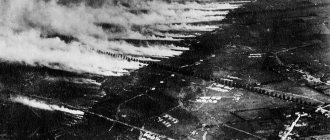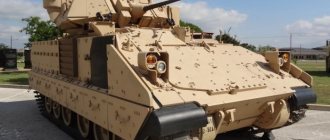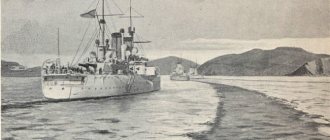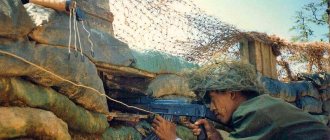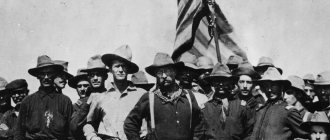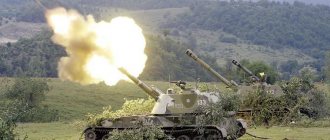On April 22, 1915, a strange yellowish-green cloud moved from the direction of the German positions towards the trenches in which the French-British troops were located. In a matter of minutes it reached the trenches, filling every hole, every depression, flooding craters and trenches. An incomprehensible greenish fog first caused surprise among the soldiers, then fear, but when the first clouds of smoke enveloped the area and made people suffocate, the troops were seized with real horror. Those who could still move fled, trying in vain to escape the suffocating death that inexorably pursued them.
This was the first massive use of chemical weapons in human history. On that day, the Germans sent 168 tons of chlorine from 150 gas batteries to Allied positions. After this, German soldiers took up positions left in panic by the Allied troops without losses.
The use of chemical weapons caused a real storm of indignation in society. And although by that time the war had already turned into a bloody and senseless massacre, there was something extremely cruel in poisoning people with gas - like rats or cockroaches.
The First World War was the only major military conflict in which poison gases were used on a large scale. During World War II, neither the Nazis nor the leadership of the anti-Hitler coalition dared to unleash a new chemical war. However, over the subsequent decades, the military was constantly preparing for it: chemists invented new types of toxic substances, and more effective means of delivering them were developed. At the international level, several conventions have been adopted that directly prohibit the development, storage and use of chemical warfare agents. But despite this, by the end of the Cold War, the USSR and the USA possessed huge arsenals of chemical weapons.
In subsequent years, such types of chemical weapons were created, in comparison with which the chlorine and mustard gas of the First World War do not seem so dangerous. Currently, the most lethal type of chemical weapons are nerve gases.
To clearly characterize the toxicity of nerve gases, one example can be given. If you open a regular laboratory tube containing soman for a few seconds while holding your breath, you will die. The gas that enters the body through the skin will kill you.
What is this type of chemical weapon? How does it work, what are its characteristics? What is the danger of these toxic substances?
Sarin
Sarin is a colorless or yellow liquid with almost no odor, which makes it difficult to detect by external signs. It belongs to the class of nerve agents. Sarin is intended primarily to contaminate the air with vapors and fog, that is, as an unstable agent. In some cases, however, it can be used in droplet-liquid form to infect the area and military equipment located on it; in this case, the persistence of sarin can be: in summer - several hours, in winter - several days.
Sarin causes damage through the respiratory system, skin, and gastrointestinal tract; acts through the skin in droplet-liquid and vapor states, without causing local damage. The degree of damage caused by sarin depends on its concentration in the air and the time spent in the contaminated atmosphere.
Signs of sarin poisoning: the victim experiences drooling, profuse sweating, vomiting, dizziness, loss of consciousness, severe convulsions, paralysis and, as a result of severe poisoning, death.
Toxicity
Soman is approximately 3 times more toxic than sarin. The symptoms of poisoning are similar, but treatment for soman poisoning is complex.
Concentrations of no more than 7 10 -7 mg/l are relatively safe. The action of soman at a concentration of 2 × 10 -5 mg/l for 15 minutes causes poisoning. Symptoms of the lesion are muscle cramps, paralysis, miosis, severe sweating, and increased salivation. Such symptoms appear when exposed to a concentration of 10 -4 for 1-2 minutes. A concentration above 2·10 -2 mg/l after 5 minutes is absolutely lethal.
Soman has the ability to penetrate the body through the skin. Concentrations of 10-20 mg/kg body weight are dangerous. Doses of 0.02-0.04 mg/kg orally are lethal.
V-gases
V-gases are low-volatile liquids with a very high boiling point, so their persistence is many times greater than that of sarin. Like sarin and soman, they are classified as nerve agents.
According to foreign press data, V-gases are 100 - 1000 times more toxic than other nerve agents. They are highly effective when acting through the skin, especially in a droplet-liquid state: contact with human skin of small drops of V-gases usually causes death.
Physical properties
Pure pinacoline methylphosphonate is a colorless liquid with a camphor odor, density 1.0131 g/cm³. Due to existing impurities, the technical product may have a yellowish-straw color.
Sarin has limited solubility in water, no more than 2.1% at 20 ° C, however, even with concentration, water still becomes unsuitable for consumption. Unlimitedly soluble in organic solvents.
Sarin does NOT distill at atmospheric pressure. Easily absorbed by porous materials (wood, concrete, brick, fabric), does not exceed painted surfaces and rubber. The ability to be adsorbed is higher than that of sarin.
The volatility of soman is: 531 mg/m³ (0°C), 3,900 mg/m³ (20°C), 5,570 mg/m³ (25°C).
Mustard gas
Mustard gas is a dark brown oily liquid with a characteristic odor reminiscent of garlic or mustard. Belongs to the class of blister agents.
Mustard gas slowly evaporates from contaminated areas; Its durability on the ground is: in summer - from 7 to 14 days, in winter - a month or more.
Mustard gas has a multifaceted effect on the body: in drop-liquid and vapor states it affects the skin and eyes, in vapor form it affects the respiratory tract and lungs, and when ingested with food and water, it affects the digestive organs. The effect of mustard gas does not appear immediately, but after some time, called the period of latent action.
Signs of damage: upon contact with the skin, drops of mustard gas are quickly absorbed into it without causing pain. After 4 - 8 hours, redness and itching appears on the skin. By the end of the first and beginning of the second day, small bubbles form, but then they merge into single large bubbles filled with an amber-yellow liquid, which becomes cloudy over time. The appearance of blisters is accompanied by malaise and fever. After 2-3 days, the blisters break through and reveal ulcers underneath that do not heal for a long time. If an infection gets into the ulcer, suppuration occurs and the healing time increases to 5 - 6 months.
The organs of vision are affected by vapor mustard gas even in negligible concentrations in the air and exposure time is 10 minutes. The period of hidden action lasts from 2 to 6 hours; then signs of damage appear: a feeling of sand in the eyes, photophobia, lacrimation. The disease can last 10 - 15 days, after which recovery occurs. Damage to the digestive organs is caused by ingestion of food and water contaminated with mustard gas. In severe cases of poisoning, after a period of latent action (30 - 60 minutes), signs of damage appear: pain in the pit of the stomach, nausea, vomiting; then general weakness, headache, weakening of reflexes occur; Discharge from the mouth and nose acquires a foul odor. Subsequently, the process progresses: paralysis is observed, severe weakness and exhaustion appear. If the course is unfavorable, death occurs between 3 and 12 days as a result of complete loss of strength and exhaustion.
By Soman Chainani
Soman Chainani
Soman Chainani's first novel, The Princess or the Witch, debuted on the New York Times Best Seller List, has been translated into 26 languages, and will soon be a major motion picture from Universal Studios.
The sequels, A World Without Princes and The Last Happily Ever After, also debuted on the New York Times Best Seller List. Collectively, the books in the series were published and remained at the top of the New York Times list for a total of 33 weeks.
As a writer and filmmaker, Soman's films have played at over 150 film festivals around the world, winning more than 30 jury and audience prizes, and his writing awards include: honors from Big Bear Lake, New Project, CAPE Foundation, Sun Valley Author Fellowship and the coveted Shasha Grant, presented by a jury of international film directors.
When he's not telling stories, he's teaching in New York City, Soman is a dedicated tennis player who never lost a first-round match for ten years... until he started writing. Now he loses all the time.
Edit description Go to website Soman Chainani Discuss Add a book
Years written
All 1000 1011 1040 1064 1088 1100 1170 1172 1176 1179 1181 1185 1188 1196 1208 1210 1212 1275 1290 1300 1307 1317 1325 1342 13 43 1355 1361 1374 1392 1418 1474 1480 1484 150 1515 1532 1533 1546 1550 1556 1564 1572 1580 1591 1593 1594 1598 1600 1602 1603 1604 1605 1607 1611 1613 1614 1615 1616 1620 1623 1625 1626 1627 1630 1631 1634 1635 1636 1637 1640 1641 1644 1645 165 1 1656 1657 1658 1659 1661 1662 1664 1665 1666 1667 1668 1669 1670 1671 1675 1677 1678 1682 1683 1686 1691 1693 1694 1695 169 7 1700 1707 1710 1713 1715 1716 1719 1720 1721 1722 1724 1726 1726 1727 1731 1732 1734 1739 1740 1742 1743 1748 1750 1751 1755 1755 1756 1759 176762 1764 1766 1770 1770 1775 1775 1775 1775 1775 1775 1775 1775 1775 1775 1775 1775 1775 1775 1775 1775 1775 1775 1775 1775 1775 1775 1775 1775 1775 1775 1775 1775 1775 1775 1775 1775 1775 1775 1775 1775 1775 1775 1775 1775 1775 1775 1775 1775 1775 1775 1775 1775 1775 1775 1775 1775 1775 1775 1775 1775 1775 177A 78 1781 1782 1786 1788 1789 1790 1791 1792 1793 1794 1795 1796 1797 1798 1802 1807 1808 1809 1810 1811 1812 1813 1814 1815 1816 1817 1818 1819 1820 1821 182 2 1823 1824 1825 1826 1827 1828 1829 1830 1831 1832 1833 1834 1835 1836 1837 1838 1839 1840 1841 1842 1843 1844 1845 1846 184 7 1848 1849 1850 1851 1852 1853 1854 1855 1856 1857 1858 1859 1860 1861 1862 1863 1864 1865 1866 1867 1868 1869 1870 1871 187 2 1873 1874 1875 1876 1877 1878 1879 1880 1881 1882 1883 1884 1885 1886 1887 1888 1889 1890 1891 1892 1893 1894 1895 1896 189 7 1898 1899 1900 1901 1902 1903 1904 1905 1906 1907 1908 1909 1910 1911 1912 1913 1914 1915 1916 1917 1918 1919 1920 1921 192 2 1923 1924 1925 1926 1927 1928 1929 1930 1931 1932 1933 1934 1935 1936 1937 1938 1939 1940 1941 1942 1943 1944 1945 1946 194 7 1948 1949 1950 1951 1952 1953 1954 1955 1956 1957 1958 1959 1960 1961 1962 1963 1964 1965 1966 1967 1968 1969 1970 1971 197 2 1973 1974 1975 1976 1977 1978 1979 1980 1981 1982 1983 1984 1985 1986 1987 1988 1989 1990 1991 1992 1993 1994 1995 1996 199 7 1998 1999 2000 2001 2002 2003 2004 2005 2006 2007 2008 2009 2010 2011 2012 2013 2014 2015 2016 2022 2018 2022 27 BC 335 BC 355 BC 380 BC 385 BC 403 BC 405 BC e. 406 BC 407 BC 409 BC 411 BC 414 BC 417 BC 428 BC 429 BC 431 BC 433 BC 441 BC 443 BC 444 BC 453 BC 458 BC 56 58 BC e. 62 63 64 65 700 BC 850 BC 935 954 976 986 II century. III century VI century VIII century X century XI century XIII century XIV century XIX century XV century XVI century XVII century XVIII century XVIII-XVII centuries BC
Original language
All Abkhaz Azerbaijani Albanian English Arabic Armenian Belarusian Bulgarian Hungarian Vietnamese Dutch Greek Georgian Danish Ancient Greek Hebrew Yiddish Indonesian Icelandic Spanish Italian Kazakh Kyrgyz Chinese Korean Kurdish Latin Latvian Lithuanian Macedonian Moldavian German Norwegian Persian Polish Portuguese Ru Manx Russian Sanskrit Serbo-Croatian Slovak Slovenian Tajik Turkish Turkmen Uzbek Ukrainian Urdu Farsi Finnish French Hindi Czech Swedish Estonian Japanese
Awards
All BookNest Fantasy Awards Buchpreis der Stiftung Ravensburger Verlag Winners Euregio-Schüler-Literaturpreis European Union Prize For Literature Fantasy Stabby Awards National Book Award Neffy Awards Prix des Deux magots Stiftung Ravensburger Verlag "Golden Dagger" "Results of the Year" from the magazine "World of Science Fiction" " Russian Prize ABS Prize American Book Award Astrea Aurealis Aelita Baskon White Spot Belyaev Prize British National Book Award British Fantasy Award Bronze Snail Bronze Icarus Booker Prize Great Ring World Fantasy Prize Goncourt Prize Hawthornden Prize Goodrids Dietmar Dublin Prize Star Mo st Zilantcon Interpresscon Chinese Prize " Galaxy Kitchis Los Angeles Times Book Award Noma Locus Literary Award John Newbery Medal International Science Fiction Award John Campbell Memorial Award Theodore Sturgeon Memorial Award Sword Without a Name Swords Mythopoetic Award Nautilus National Book Award National Bestseller German Science Fiction Neffie Prize Nobel Prize New Horizons Orange Crime Writers Association Dagger Awards DragonCon Convention Awards Alex Award Children of the Night Award NOSE Award Hugo Award SFinks Award WORDS AWARD 505 Kelvin Award Bob Moran Award Big Award book Italia Award Companion Award It's Horror Award Agatha Christie Award Academy Science Fiction, Fantasy and Horror Award Akutagawa Award Apollo Award Arthur C. Clarke Award Pacific Northwest Booksellers Association Award Betty Trask Award Children's Bloggers Award and Young Adult Literature British Science Fiction Association Prize Bram Stoker Prize Walter Scott Prize Wodehouse Prize Goethe Prize Geffen Prize Dazai Osamu Prize James Tait Prize James Tiptree Jr. David Gemmell Prize Yomiuri Prize Nowa Fantastyka Prize Julie Verlanger Prize Foreign Book Award Mia Ignotus Prize named after. Janusz A. Seidel Sanjugo Naoki Award Shirley Jackson Award Esther Glen Award Endeavor Award Costa Award (Whitbread) Kurt Lasswitz Award Literary Excellence Award Lord Ruthven Award Medici Award International Horror Guild Award Nebula Award Nero Wolfe Award Noct Award O. Henry Prize Mia Prometheus Award Romulo Gallegos Award Somerset Maugham Award Strega Award Seiun Award Tanizaki Award Triumph Award Femina Award Philip K. Dick Award/Best SF Book in the United States Faulkner Award Science Fiction Chronicle Readers Award Asimov Readers Award Edgar Allan Poe Award Edogawa Rampo Yukio Mishima Prize Pulitzer Prize RosCon Manuscript of the Year Russian Booker Sidewise Silver Arrow Sigma-F Constellation Ayu-Dag Recommended reading list from the American Library Association Glass Key Wanderer Fancon Filigree Folio Horror summary on FantLab
Hydrocyanic acid
Hydrocyanic acid is a colorless liquid with a peculiar odor reminiscent of the smell of bitter almonds; in low concentrations the odor is difficult to distinguish. Hydrocyanic acid evaporates easily and acts only in a vapor state. Refers to general toxic agents.
Signs of damage: metallic taste in the mouth, throat irritation, dizziness, weakness, nausea. Then painful shortness of breath appears, the pulse slows down, the poisoned person loses consciousness, and sharp convulsions occur. Convulsions are observed for a relatively short time; they are replaced by complete relaxation of the muscles with loss of sensitivity, a drop in temperature, respiratory depression followed by its cessation. Cardiac activity after stopping breathing continues for another 3 to 7 minutes.
Receipt
The same synthesis scheme is suitable for soman as for sarin. The starting materials are chloroform and methylphosphonic acid fluoroanhydrides, as well as pinacolin alcohol (3,3-dimethylbutan-2-ol):
The alcohol is obtained by reduction with sodium amalgam or catalytic hydrogenation of pinacoline with hydrogen:
Pinacolina, in turn, is synthesized from acetone by electrochemical means, converting it into pinacone, followed by rearrangement:
Also, pinacoline alcohol can be obtained by the Grignard reaction - with tert-butylmagnesium halide and ethanal:
Phosgene
Phosgene is a colorless, highly volatile liquid with the smell of rotten hay or rotten apples. It acts on the body in a vapor state. Belongs to the class of suffocating agents.
Phosgene has a period of latent action of 4 - 6 hours; its duration depends on the concentration of phosgene in the air, the time spent in the contaminated atmosphere, the condition of the person, and the cooling of the body.
Signs of damage: when inhaling phosgene, a person feels a sweetish, unpleasant taste in the mouth, followed by coughing, dizziness and general weakness. Upon leaving the contaminated air, the signs of poisoning quickly pass, and a period of so-called imaginary well-being begins. But after 4 - 6 hours, the affected person experiences a sharp deterioration in their condition: a bluish discoloration of the lips, cheeks, and nose quickly develops; general weakness, headache, rapid breathing, severe shortness of breath, a painful cough with the release of liquid, foamy, pinkish sputum appear, indicating the development of pulmonary edema. The process of phosgene poisoning reaches its climax phase within 2 - 3 days. With a favorable course of the disease, the affected person’s health will gradually begin to improve, and in severe cases of damage, death occurs.
↑ Pathogenesis
Organophosphorus substances, absorbed through the mucous membranes and skin, enter the blood and penetrate with it into all tissues of the body.
It is known that FOBs have the property of inhibiting the function of vital enzymes, such as cholinesterase, dehydrogenase, phosphatase, thrombin, trypsin, etc. The greatest consequences for the poisoned organism result from inhibition of the activity of cholinesterases.
Cholinesterases are enzymes that regulate in the body the amount of an active substance involved in the conduction of nerve impulses through synaptic formations - acetylcholine. Substances with such properties are called mediators. Acetylcholine is released at the ends of excited centrifugal nerves and causes excitation of the innervated cell. Nerves that excite the cell using acetylcholine are called cholinergic. As soon as the excitation of the cholinergic nerve stops, the excited cell must go into a resting state, for which acetylcholine must be destroyed. Acetylcholine, with the participation of cholinesterases, is broken down into choline and acetic acid.
When poisoning with OPA, as a result of their ability to inhibit the activity of cholinesterases, a large amount of acetylcholine accumulates in the body, which maintains cells sensitive to this mediator in a state of prolonged excitation. The mediator acetylcholine causes excitation of cells in various organs and tissues: in the central nervous system, autonomic ganglia, in all internal organs, as well as in motor muscles. With the accumulation and retention of acetylcholine in these organs, pathological excitation remains, and if exposed to a very large amount of the mediator, paralysis of their function may occur. Thus, an excess of acetylcholine in skeletal muscles initially leads to its tension and causes twitching of individual fibers (fibrillation). If the mediator continues to accumulate, muscle tone decreases - they relax and become unable to contract.
If these phenomena develop in the respiratory muscles, death occurs from cessation of external respiration. This phenomenon is called neuromuscular block, or relaxation of the respiratory muscles. The accumulation of acetylcholine in the bronchi and intestines leads to a contraction of the muscles of these organs - bronchial spasm, intestinal spasm or increased peristalsis develop. The muscles of the arterioles relax under the influence of acetylcholine, so blood pressure decreases and the heart rate slows down. There is an indication that FOBs affect the cholinoreactive structures of the body not only indirectly (through acetylcholine), but also directly (by interacting with them).
Inhibition of FOB enzymes phosphoglucomutases and dehydrogenases, which are involved in the activation of oxidative processes occurring in cells and providing them with the necessary energy, leads to energy starvation of tissues. This exacerbates the harmful effects of excess acetylcholine.
Thus, inhibition of cholinesterase activity and the associated accumulation of acetylcholine in the body during FOB poisoning distorts the normal functioning of the central and peripheral nervous systems and, naturally, all organs.
